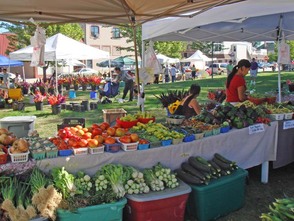
------------------
Growing up in spanking-new suburban housing, my family didn’t live far from local farmlands. My mother used to drive us to a nearby farm stand named Styer’s, where freshly picked fruits and vegetables lay heaped in bins and the plank floors were strewn with straw and caked mud. I still remember how in the summer the backseat would be loaded with bags of sweet corn, blushing peaches, and juicy tomatoes; the fall harvest brought pumpkins, crisp apples, and fragrant pears.
Nowadays I buy my produce in the supermarket, but the results are often disappointing. My husband complains the grapes are tasteless and the peaches degenerate with frightening rapidity from rock-hard to bruised mush. But what should I expect? As Barbara Kingsolver notes in Animal, Vegetable, Miracle, “The average food item on aUS grocery shelf has traveled farther than most families go on their annual vacation.” Her husband, Stephen Hopp, quantifies this more precisely: Each item travels an average of 1,500 miles.
Fortunately, the enterprising balabusta doesn’t have to limit herself to the corner supermarket. When large supermarket chains sprouted across America, farmers’ markets fell out of fashion, but today you see them reemerging in large numbers. They’re supported by government initiatives aimed at reintroducing our overweight-but-undernourished population to nature’s bounty. Many markets even have authorization to accept food stamps and WIC. The Greenmarket Farmers Markets association in New York currently includes 53 markets and 230 suppliers, a far cry from its humble beginnings in 1976 in a parking lot where 12 farmers set up shop.
Farmers’ markets may be making a comeback, but they’ve existed about as long as there’s been profit farming. Middle Eastern countries had their souks, and European villages had their market days; in cities likeParisandLondon, large markets like Les Halles or Covent Garden operated daily (and still do, although the originalCovent Gardenmarket has moved several miles away). The kaleidoscope ofJerusalem’s Machaneh Yehudah marketplace is a must-see for any tourist.
In the US, the oldest continually functioning farmers’ market is the Lancaster Central Market, which began in 1730. Located in the heart of Pennsylvania’s Amish country, it still offers local specialties such as “chowchow” (pickled vegetables with spicy mustard) and “scrapple” (a treif sausage made with cornmeal and meat scraps). West of theMississippi, the oldest market is the Soulard Farmers Market inSt. Louis,Missouri; it was inaugurated in a meadow in 1779 and has survived tornadoes and land disputes resulting from theLouisiana Purchase in 1803.
The farmers’ markets of today have become more than just stands selling produce; they’re places to mingle and hear street musicians, to learn about food by watching cooking demonstrations, and attend events with names like “Meet Your Fishmonger.”
Farmers’ markets are a boon for ethnic cooks. Poopa Dweck, the author of Aromas of Aleppo, says she regularly shops in farmers’ markets to find specialty vegetables like miniature eggplants. “That’s the way my mother used to shop inSyria, where they didn’t have supermarkets,” she says.
One of my married daughters surprised me by informing me there’s a farmers’ market right in our own backyard — Friday mornings on the grounds nearConey IslandHospital. “The sweet corn is amazing,” she said. “And most of it’s organic. Whenever possible in the summer, I walk the half hour to get there.” And although my mother has since moved far from Styer’s, there’s now a Sunday morning market in her new Philadelphia neighborhood, complete with bleating sheep for children to pet and demonstrations of sheepshearing and wool carding.
 RSS Feed
RSS Feed